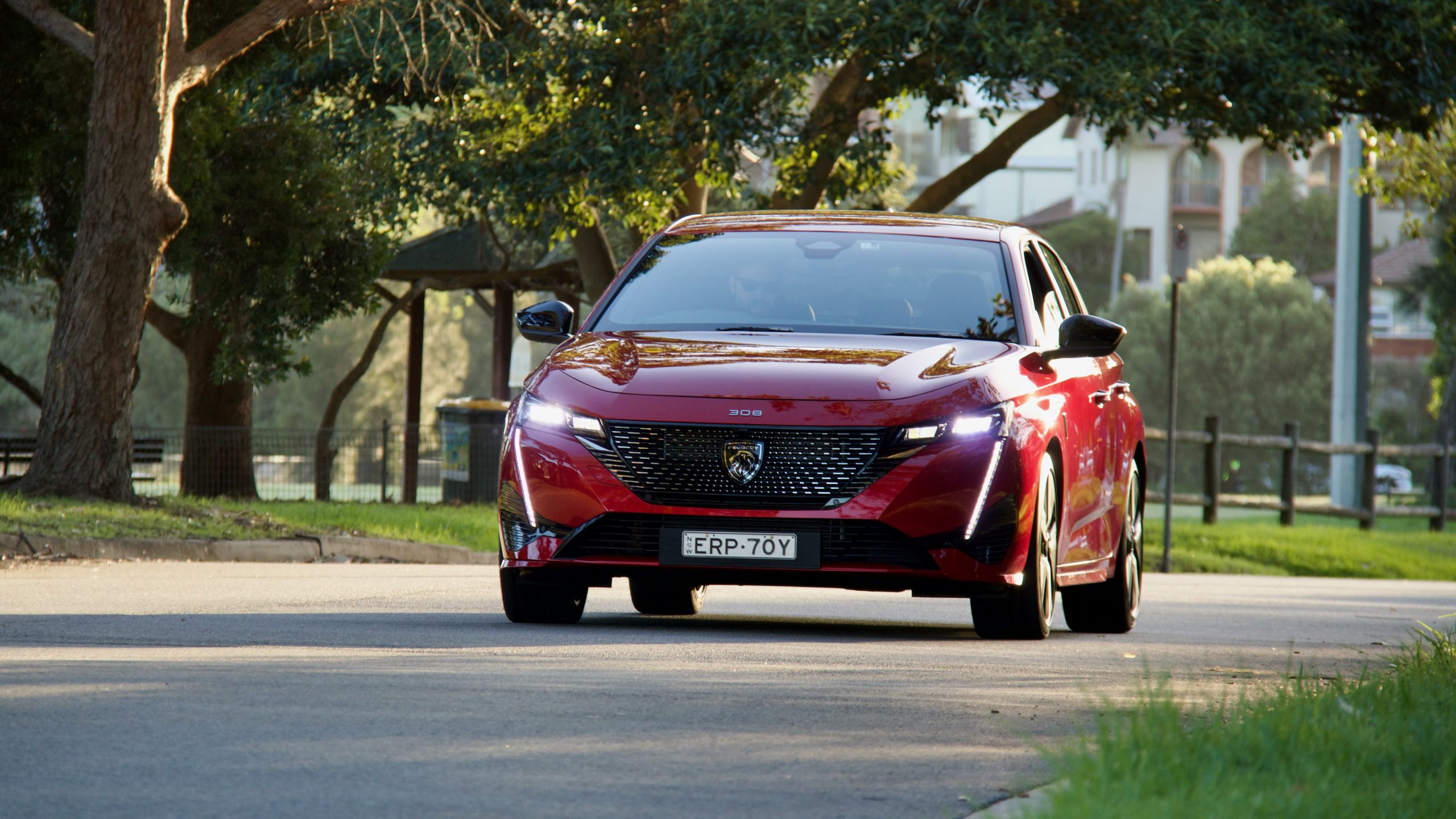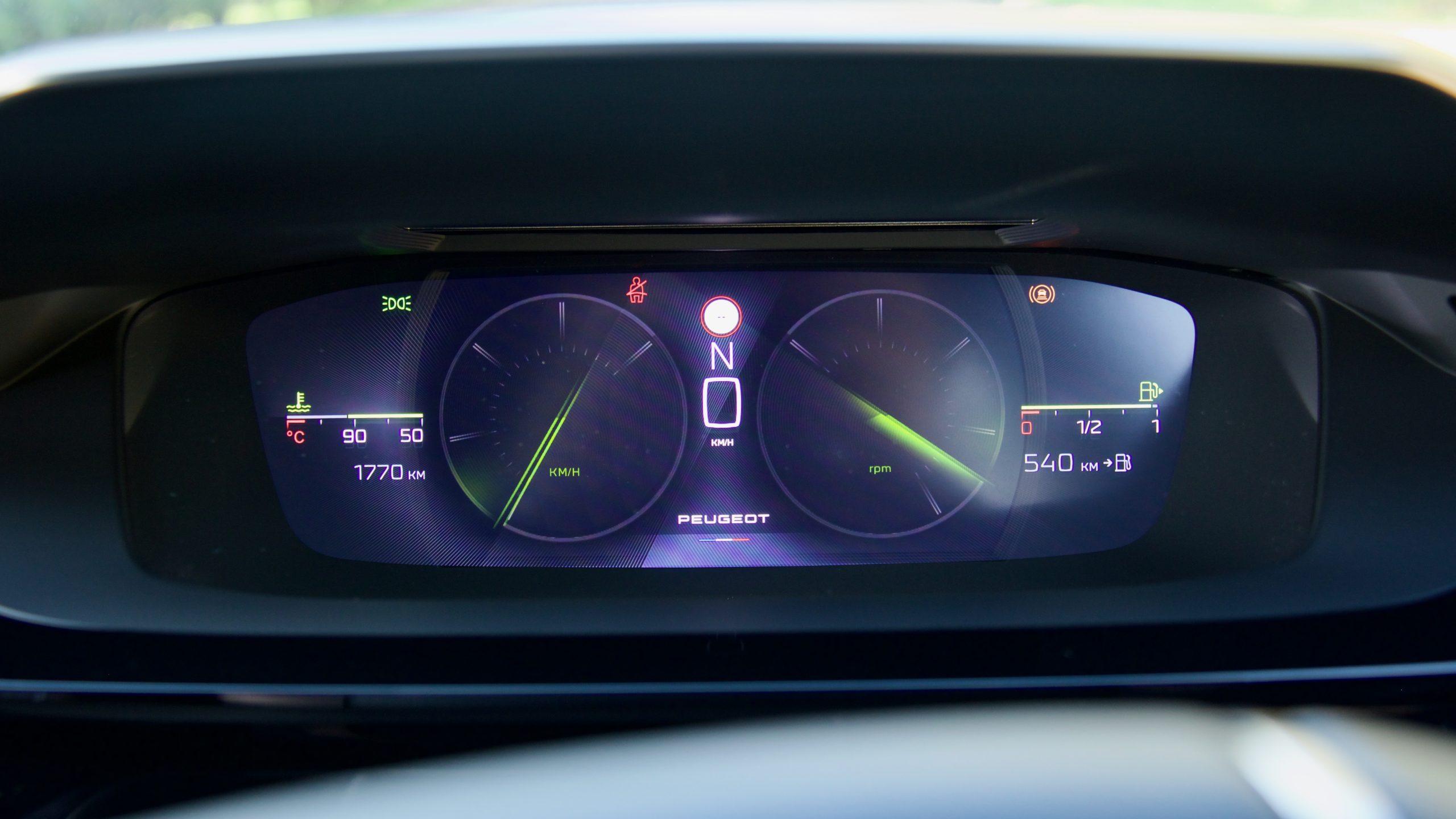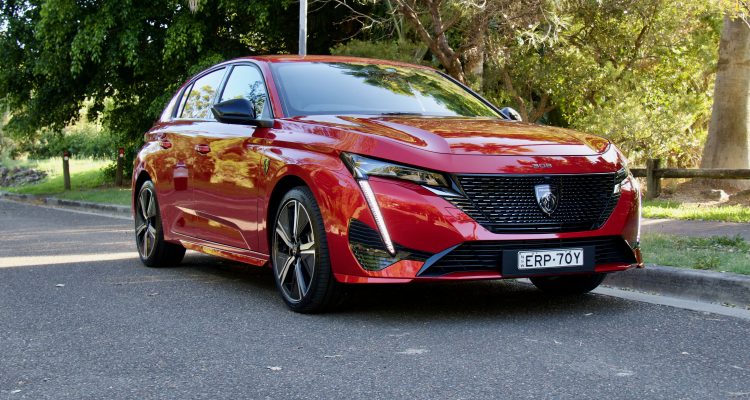- Exotic styling and great interior quality
- Wonderful ride and handling balance
- Loaded with standard equipment
- Thirsty engine only adequate
- Not cheap to buy or service
- No spare wheel is annoying
In the past five or so years, the rise of the SUV has been particularly noticeable. Look around and no matter the brand, it’s SUVs galore. Almost every brand – including even Ferrari – has committed to the SUV bodystyle in the hope of increasing their global sales, and that has come as the cost of segments that sold well for decades before that, like small hatchbacks. As such, some companies like Ford have confirmed that there will be no next-generation hatchback models in their lineup, greatly disappointing enthusiasts around the world. Thankfully, manufacturers like Peugeot remain committed to the hatchback, so can the 2023 Peugeot 308 GT carry the weight of hatchback fans in Australia? Let’s find out.

The 308 competes with cars like the Volkswagen Golf, Mazda3, Honda Civic, Toyota Corolla, Cupra Leon and Hyundai i30, but with its more premium positioning this time around, it’s also within grasp of premium brands like the BMW 1 Series, Mercedes-Benz A-Class and Audi A3.
Price & Equipment: 7/10
For now, there are two grades of Peugeot 308 hatchback in Australia: the entry-level GT we’re testing here and the higher-spec GT Premium, with a wagon variant of the GT Premium also available. The GT is priced from $43,990 plus on-road costs (around $48,500 drive away, depending on location) – $5,000 less than the GT Premium hatchback. A GT Sport plug-in hybrid is due in Australia later in 2023.




Standard equipment on the 2023 Peugeot 308 GT hatchback includes 18-inch alloy wheels, automatic all-LED lighting with front and rear daytime running lights, automatic wipers (that activate the headlights), suede and synthetic leather upholstery, an eight-way manually adjustable driver’s seat, keyless entry and start, heated and auto-folding mirrors, a heated leather steering wheel, dual-zone climate control with rear air vents, a 10-inch touchscreen with wireless Apple CarPlay and Android Auto, a 10-inch digital driver’s display, satellite navigation with live traffic, digital radio, a wireless phone charger, a six-speaker sound system, four USB-C ports, voice control and a three-year connected services subscription (for features like weather and live traffic).
Safety equipment includes six airbags, auto emergency braking (AEB) with low-light pedestrian and cyclist detection, lane keeping assistance, adaptive cruise control with stop and go functionality, blind-spot monitoring with rear cross-traffic alert, driver attention monitoring, Matrix adaptive high beam functionality, speed sign recognition, front and rear parking sensors and a reversing camera. The 308 has a four-star Euro NCAP rating from 2022.




The only no-cost colour option for the 308 is ‘Olivine Green’, while ‘Artense Grey’ and ‘Nera Black’ cost $690 extra and ‘Vertigo Blue’, ‘Pearl White’ and our test car’s ‘Elixir Red’ (the colours of the French flag) cost $1,050. The only interior colour option is black with lime green stitching.
We consider three cars to be the 308 GT’s main rivals: the Mazda3 G25 Astina (around $45,000 drive away), the Volkswagen Golf R-Line (around $45,500 drive away) and the Honda Civic VTi-LX ($47,200 drive away). The Peugeot is comfortably the most expensive of this group, though it also has less standard equipment than the Mazda3 Astina in particular.




Over the Peugeot, the Mazda features leather upholstery, a 10-way electrically adjustable driver’s seat with memory functionality, an extra airbag, a 360-degree camera, front-cross traffic alert, reverse automatic braking, lane trace assist, a 12-speaker Bose sound system and a rear centre armrest for $3,500 less. Over the Mazda, the Peugeot features a larger touchscreen with wireless smartphone mirroring, a wireless phone charger, online services, two extra USB ports (and newer USB-C ports too) and a 10-inch digital driver’s display. But is all of that worth an extra $3,500? We don’t think so.
Performance & Economy: 7/10
Under the bonnet of the 2023 Peugeot 308 GT is a 1.2-litre turbocharged three-cylinder petrol engine that makes 96kW of power (at 5,500rpm) and 230Nm of torque (at 1,750rpm). It’s mated to an eight-speed torque converter automatic transmission capable of sending the 308 from 0-100km/h in a claimed 9.7 seconds. It’s a characterful engine with a lovely three-cylinder burble, but it’s not especially quick.




The engines in competitors – a 139kW/252Nm 2.5-litre non-turbo engine in the Mazda3, a 110kW/250Nm 1.4-litre turbo engine in the Golf and a 132kW/250Nm 1.5-litre turbo engine in the Civic – all feel noticeably punchier than the 308’s engine. In particular, the Mazda’s 139kW donk feels positively muscular in comparison, punching out a full 43kW more power, though even the Golf’s excellent 1.4-litre turbo engine still feels quick compared to the Peugeot. The Peugeot’s engine is more than fine around town, and it’s also nicely quiet too, but competitors offer more punch when asked for it.
The only transmission available in the 308 range is an eight-speed Aisin torque converter automatic that features paddle shifters for manual control. As we’ve seen in other Peugeot Citroen products, it’s a mostly great gearbox – only some brief low-speed hesitation makes it less than perfect. We find it to be nicer to use than the Civic’s droning CVT automatic, and interestingly, Volkswagen uses a similar Aisin-sourced gearbox in the Mk8 Golf 110TSI.




The claimed fuel consumption for the 308 GT is 5.3L/100km, with CO2 emissions rated at 120g/km, which compares well to the 6.5L/100km, 5.8L/100km and 6.3L/100km ratings of the Mazda, Golf and Civic respectively. The 308 needs to be filled with minimum 95RON premium unleaded fuel – like the Golf, but unlike the Mazda3 and Civic – and has a 52-litre fuel tank. In our testing however, the 308 was a lot thirstier (particularly in urban driving) with an 8.2L/100km combined result.
Ride & Handling: 9/10
Based on PSA’s ‘EMP2’ platform, which is shared by a lot of other fine handling cars like the Citroen C5 X, the 2023 Peugeot 308 GT rides and handles quite well. As its GT badging would suggest, it gives off a great sports-luxury vibe from behind the wheel, and mixes a nicely firm ride with balanced handling. The steering is light, but reasonably fast, while the ride – despite the torsion beam rear suspension set up – is quite comfortable as well, but nicely taught.




At speed, the 308 is relatively quiet for road noise and its visibility is pretty good too, especially against the Mazda3 and its thick C-pillar. The 308’s active safety features also work quite well, though it does offer up some random beeps without reason. The 308’s ‘i-Cockpit’ driver’s display with the small steering wheel and driver’s display above it can take some time getting used to, especially if you’re short or quite tall, but for somebody of around average height, it works quite well.
Interior & Practicality: 9/10
As we’ve become used to with Peugeot’s products over the past half decade, the 2023 Peugeot 308 GT’s interior is excellent. It’s covered in great quality materials, it’s exciting to look at and it’s quite comfortable – but compared to the last generation 308, the technology is now far more impressive, while storage and practicality in the front cabin has been given a big boost as well.

No matter where you touch in the 308’s cabin, it feels suitably posh. From the suede and synthetic leather seats to the lovely small leather steering wheel with lime green stitching and to the liberal use of soft touch materials almost everywhere – even on the centre console against your knees – the 308’s cabin is decidedly premium. Against the disappointing Mk8 Golf and average Civic, the 308’s cabin feels quite luxurious and this goes towards justifying its price tag – though the Mazda3’s cabin offers a similarly luxurious vibe for a lot less money.
Storage inside the 308’s cabin has gone from one of the worst in the segment with the old model, to one of the best. It’s got a deep box underneath the centre armrest (with a USB-C charging port inside that has a secret tunnel so cables can be fed outside with the lid closed), big cup holders on the centre console, a deep tray underneath the centre console, a wireless charger underneath the centre screen, large flock-lined door bins and a huge glovebox as well.




Centre of the 308’s cabin is a 10-inch touchscreen that’s fully featured with wireless Apple CarPlay and Android Auto, satellite navigation with live traffic, digital radio and even live services such as weather and car park searching. As we found recently in the Citroen C5 X – which shares the 308 screen’s basic layout and functionality, though with different colouring – it’s a big step up on the older-generation Peugeot system still used in the rest of the range, with much quicker response times, a higher quality screen and it’s an overall easier system to use. The six-speaker sound system is surprisingly good too.
The back seat of the 308 is not its strong point, however, as it’s a bit tight for taller adults – headroom is fine, but legroom isn’t as commodious as the roomy Civic. It has a lot of features, with air vents, two USB-C charging ports, two map pockets and reasonable door pockets – though there’s no centre arm rest with cup holders or separate climate zone (both of which the Golf has), unfortunately.




The boot of the 308 GT is a more positive story than the back seat, however, as it’s one of the largest in the segment at 412-litres with the seats up – 107L larger than the Mazda3 – and 1,323L with them folded. The boot has a few features like a net on the side for more fragile items and under floor storage as well – the latter is there because the 308 range does not have a spare wheel, like the Civic but not the Golf or Mazda3. There’s an annoying step between the seats being folded and the boot floor as well – like the Civic, but not the Golf or Mazda3 – though the space on offer is healthy for the segment.
Service & Warranty: 8/10
The 2023 Peugeot 308 GT has a five-year/unlimited km warranty with five years of roadside assistance as standard. Its service intervals are once yearly/every 15,000km (whichever comes first), and five years/75,000km of servicing costs $2,489 ($497 per service) – but buyers can pre-pay for servicing at the time of purchase and a five year/75,000km pack costs a more reasonable $1,800 ($360 each).

Mazda, Volkswagen and Honda all offer the same five-year/unlimited km warranties – Mazda and Honda give you five years of roadside assistance from the get go, whereas Volkswagen gives you 12 months’ worth, but that’s increased yearly up to 10 years in total if serviced at a Volkswagen dealership. Five years of servicing the Mazda3 costs $2,011 ($402 per service), the Golf costs a huge $3,356 ($671 per service) and the Civic costs just $995 (only $199 per service). Keep in mind that the Mazda3 and Civic’s service intervals are only once-yearly/every 10,000km, which is 5,000km less than the Golf and 308.
The 2023 Peugeot 308 GT DiscoverAuto Rating: 8.0/10
Overall, the 2023 Peugeot 308 GT is a great all-round product that’s very capable of keeping both A) hatchback and B) Peugeot sales kicking along nicely in Australia. It offers quite a lot to buyers: exotic styling, an excellent quality interior, a big boost in technology that gives the best in the segment a run for their money, a great ride and handling balance and a nice dose of French character as well.

Of course, it isn’t perfect – the engine is merely adequate and can be quite thirsty, the transmission can be a bit dopey at low speeds, the rear seat isn’t huge and it does miss out on some bits of equipment that cars costing less – like the Mazda3 Astina – feature as standard. But we think these are small negatives in a very positive overall story and overall, the new 308 offers a lot more than the old one – and, in our opinion, offers more than a lot of cars in the segment as well.

Leave a Reply